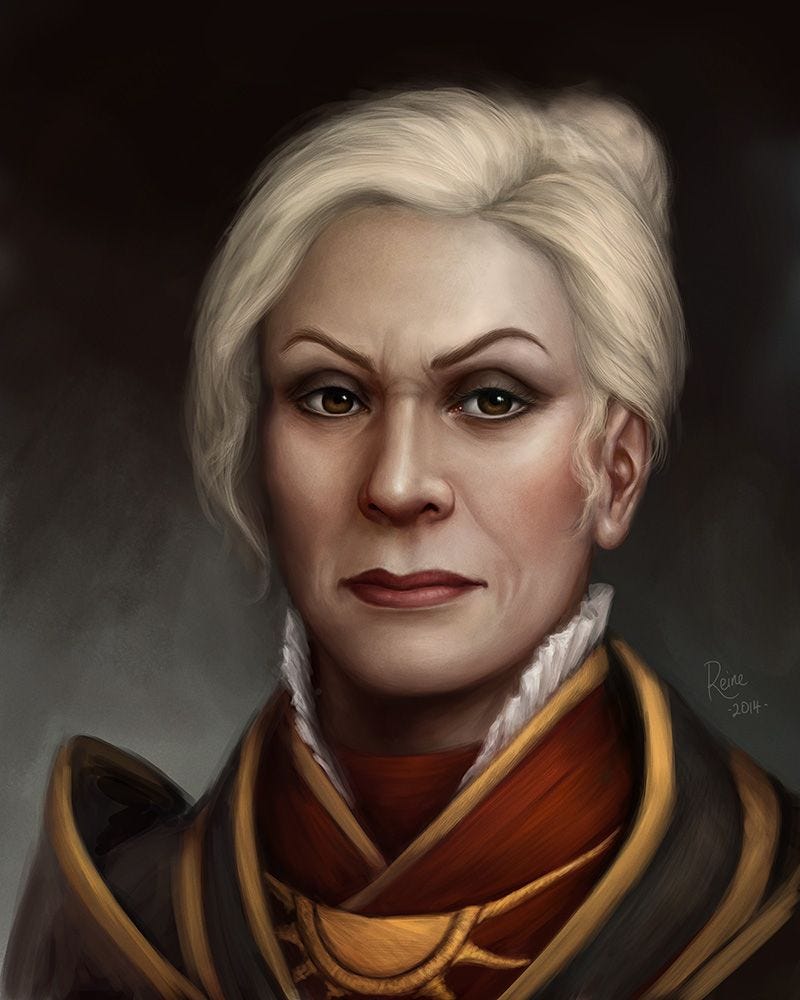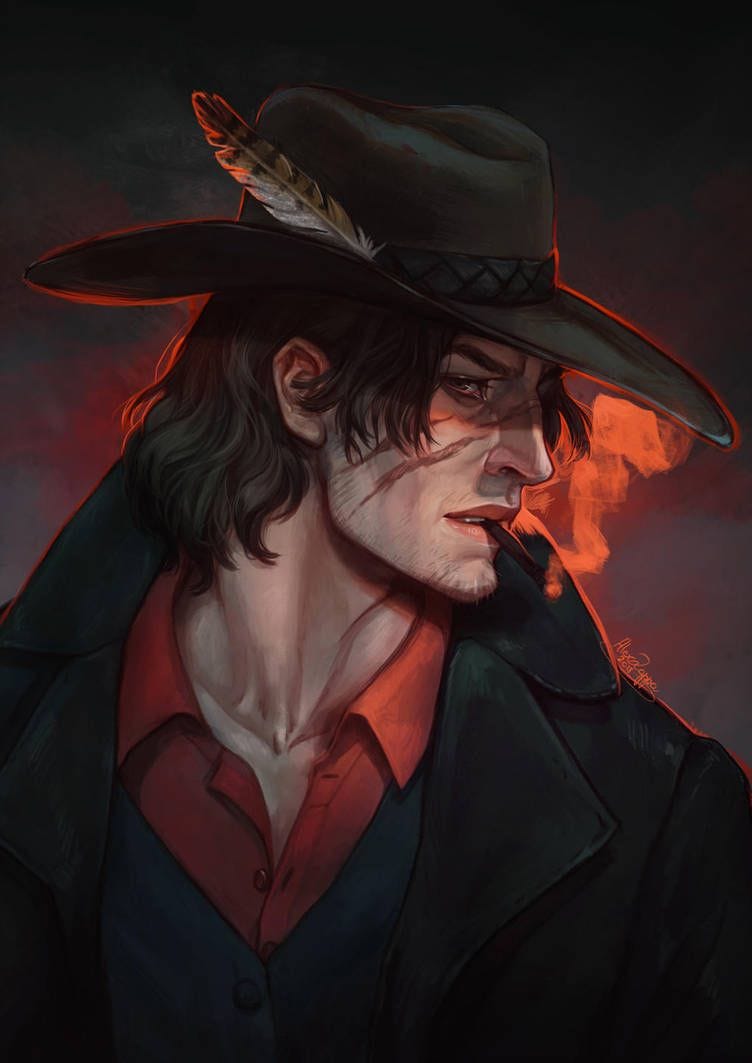Prepping Three-Dimensional NPCs with Fewer Words
And why all your NPCs should be two-dimensional first.
The conventional advice online on prepping NPCs for d&d goes something like this:
Name
Species/race
Occupation or title
Physical description
General personality
Goal
A secret they hold
Quirk (could be a funny habit, a weird manner of speech, an iconic tattoo, etc.)
Flaw
Areas of knowledge, as well as any skills, weapons, or magic abilities
I think that’s way too much, both for me and my players. Even if I had time to prep all this, and even if I could accurately roleplay all of it, this is too much information for players to remember.
If you ask your players to describe an NPC, they’ll only use a couple words anyway. So I use an equal number of words in my prep.
Brevity is a virtue.
I’m Colin, and I’m a professional video game designer. This is Drolleries, where I write about d&d, ttrpgs, and game design. This week, I’m finally using my screenwriting minor.
Succinct Characters in Screenwriting
It’s the same in screenwriting: nobody wants to read your five-page character backstory, they want to see action happen. Characters are defined by their actions, so stop describing and let them do things.
In Aliens (1986) by James Cameron, this is how the character Burke is first introduced:
He is thirtyish and handsome, in a suit that looks executive or legal, the tie loosened with studied casualness. A smile referred to as "winning.”
You understand his vibe immediately. Young corporate guy, possibly successful, not too uptight. He’s empathetic and trustworthy, even if his smile is a bit false.
We don’t know his goal or flaw, we don’t know his unique quirk, we don’t even get much description of his physical appearance. We only know handsome, suit, and smile. But that’s enough to describe him. It doesn’t matter which specific actor plays him, whether he’s tall or short, gaunt or burly, what color his eyes are, or what ethnicity he is.
That’s because casting specific actors is not the screenwriter’s job - it’s not required to convey the essence of the character.
But I think the same should be true for d&d and ttrpgs. Because this is a game that lives only in our imagination, specific physical descriptions don’t matter nearly as much as the character’s vibe. Considering how much players can forget between sessions (and even during), the character’s aura needs to be simple and immediately obvious.
The only specific detail in Burke’s description is “the tie loosened with studied casualness.” But that detail is only memorable because it’s in line with Burke’s already-established vibe.
Not All Details are Memorable
When writing NPCs, much of the advice online focuses on adding details to make NPCs feel more “fleshed-out.” They say to give your NPC a tattoo or a scar or a unique quirk in order to make them more memorable. But this doesn’t work in most cases.
As an example, I used the donjon NPC generator to generate a bunch of NPCs, and this is the first one I got.
Daalna: Female Elf Druid, Neutral. Str 12, Dex 13, Con 9, Int 12, Wis 15, Cha 11. Daalna has a round face, with curly grey hair and large hazel eyes. She wears leather armor and wields a quarterstaff and darts. Daalna is complacent but brave.
Why is it important that she has “curly grey hair” and “large hazel eyes”? I don’t think any of my players would remember those facts. And what does it mean by “complacent but brave”? How do I convey that to my players? Why does that matter?
None of these details create meaning.
Of course, this is a random NPC generator, so it’s literally just filling in the blanks with random details, but that’s my point. Random details don’t create a good NPC that players will remember.
What if we described Daalna like this instead?
Daalna (she/her, young elf, innocent, naive teenager seeking adventure, overequipped with weapons)
I left out most of the details, especially the physical ones, but it’s more memorable because I distilled her character down to a core essence. The only detail I included, “overequipped with weapons,” is memorable because it fits with who she is. She’s carrying tons of weapons because she seeks adventure, it shows her being naive and innocent.
As a GM, this is more helpful to me. I can describe her actions, the way she carries herself, and the way she talks with the PCs, and they’ll all be consistent. Her hair color or build doesn’t matter as much, cause my players will forget all that anyway.
This is an example of a good two-dimensional character. But when do we make them three-dimensional?
NPCs Should Start Two-Dimensional
In Star Wars (1977), this is how the script introduces Han Solo:
Han is a tough, roguish starpilot about thirty years old. A mercenary on a starship, he is simple, sentimental, and cocksure.
Again, this description all points to a specific vibe. No unnecessary details.
But notice how the script doesn’t mention his heart of gold, or his ultimate desire to do the right thing, or his loyalty to his friends. All of that complexity, everything that makes Han a three-dimensional character, is all revealed later through the events of the story.
Every character is two-dimensional in their first appearance.
Once again, I think the same should be true about ttrpgs, for three reasons.
Introducing a fully-realized three-dimensional character is too much for players to remember and internalize. In order to model and predict an NPC’s behavior, players need a simple starting point.
The GM doesn’t know which NPCs will be important to the story, or even which ones players will take an interest in. Let NPCs become three-dimensional when (or if) the opportunity arises.
The moment when an NPC becomes three-dimensional by not doing the obvious thing is a valuable moment of escalation. It can be a positive or a negative thing for the players, but either way, it is a pivotal moment that can raise the stakes and move the plot forward.
The reason Burke from Aliens is a memorable character is that the full complexity of his character is kept from the audience until a pivotal moment in the plot. At first, he seems two-dimensional to both Ripley and the audience: his behavior seems predictable.
But when shit hits the fan, we realize we’ve severely underestimated him this whole time, and his character becomes fully three-dimensional. That moment would be ruined if the GM spoiled the surprise by making his secret clear in the first scene.
Breaking Into Three Dimensions
The moment an NPC becomes three-dimensional is the moment they do something that challenges who the players think they are.
When the rogueish starpilot who only cares about money sticks his ass out for you because he didn’t want to have your death on his conscience, that character just became three-dimensional. He did something the player characters didn’t expect, and now they understand the complexity of his inner world, how his beliefs and morals do battle inside his head when he makes a difficult decision.
As an example, I’ve added details to make Daalna three-dimensional.
Daalna wants to leave her elven home and see the human lands. Thinks her family is privileged and sheltered, so feels guilty on behalf of them. Wants to be seen as a hero by humans she helps, but many despise her as a foreigner.
I wouldn’t mention any of this in the first scene Daalna is introduced. In that scene, she’s just an enthusiastic elven girl who wants adventure. She might seem naive by trying to convince the PCs to bring her along with them, regardless of how dangerous it seems.
But later, when the PCs ask her, or when they encounter some human farmers who may be scared of elves, I could introduce this complexity. Daalna might seem ashamed or hesitant to interact with the humans, which contradicts her earlier vibe of constant enthusiasm.
But importantly, if the PCs didn’t seem to take much interest, or if Daalna’s character didn’t turn out to be important to the player’s story, I might ignore that part and continue playing her as two-dimensional.
That’s enough theory. Now here’s some examples for how I prep NPCs.
NPC Examples
Blodwedd (he/him, middle-aged elf, seasoned paramilitary veteran, greying buzzcut, cruel & jaded, unfazed by violence)
“Killin’ is how we survive. You just gotta grow a stomach for it.”
Blodwedd believes humans are inherently evil because they provoke war against the elves and invade their land. Wants to win freedom for the elves at any cost. Thinks the elves need to be feared in order to survive. Doesn’t enjoy killing, but not sensitive to suffering anymore. Only person he cares about in the world is his nephew Caerwyn, whom he loves dearly and wants to keep away from the violence he inflicts.
Bishop Maud de Lisle (she/her, 60s, strict headmaster vibe, perfect posture, always seems disappointed)
“Do you know what the Church of Rheda has done for your Lord? I will not speak to an errand-boy. If the Duke wishes to speak to me directly, he may present himself to me.”
Maud despises nobility, believes they’re all stupid and privileged. Believes she’s the only one who deserves to be nobility. Insecure about the fact that the nobles outrank her in terms of status, and she has to be polite to them in official settings, even as they demean her. Needs their approval for Church business, and hates it.
Wesley (he/him, handsome cowboy, suave & good-mannered, puffs black smoke from huge cigar)
“I must say, miss, you’ve got a mighty fine palace here. Would make my mother jealous.”
On the surface, Wesley is a polite man who remains calm when slighted. Secretly, he is an ancient red dragon named Asganirodigorath. Only cares about money, uses his disguise to make friends with powerful people. Believes everyone is inferior to him. Takes incredible effort to hide his deep rage. When truly offended, he loses his shit.









Great article, looking forward to more
Great idea here: npc in-depth description comes only AFTER a flash description, a kind-of 'first-sight impression'! And this should always be present in the npc description!